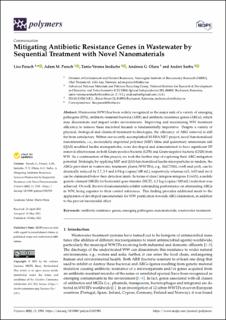| dc.description.abstract | Wastewater (WW) has been widely recognized as the major sink of a variety of emerging pathogens (EPs), antibiotic-resistant bacteria (ARB) and antibiotic resistance genes (ARGs), which may disseminate and impact wider environments. Improving and maximizing WW treatment efficiency to remove these microbial hazards is fundamentally imperative. Despite a variety of physical, biological and chemical treatment technologies, the efficiency of ARG removal is still far from satisfactory. Within our recently accomplished M-ERA.NET project, novel functionalized nanomaterials, i.e., molecularly imprinted polymer (MIP) films and quaternary ammonium salt (QAS) modified kaolin microparticles, were developed and demonstrated to have significant EP removal effectiveness on both Gram-positive bacteria (GPB) and Gram-negative bacteria (GNB) from WW. As a continuation of this project, we took the further step of exploring their ARG mitigation potential. Strikingly, by applying MIP and QAS functionalized kaolin microparticles in tandem, the ARGs prevalent in wastewater treatment plants (WWTPs), e.g., blaCTXM, ermB and qnrS, can be drastically reduced by 2.7, 3.9 and 4.9 log (copies/100 mL), respectively, whereas sul1, tetO and mecA can be eliminated below their detection limits. In terms of class I integron-integrase I (intI1), a mobile genetic element (MGE) for horizontal gene transfer (HGT), 4.3 log (copies/100 mL) reduction was achieved. Overall, the novel nanomaterials exhibit outstanding performance on attenuating ARGs in WW, being superior to their control references. This finding provides additional merit to the application of developed nanomaterials for WW purification towards ARG elimination, in addition to the proven bactericidal effect. | en_US |

